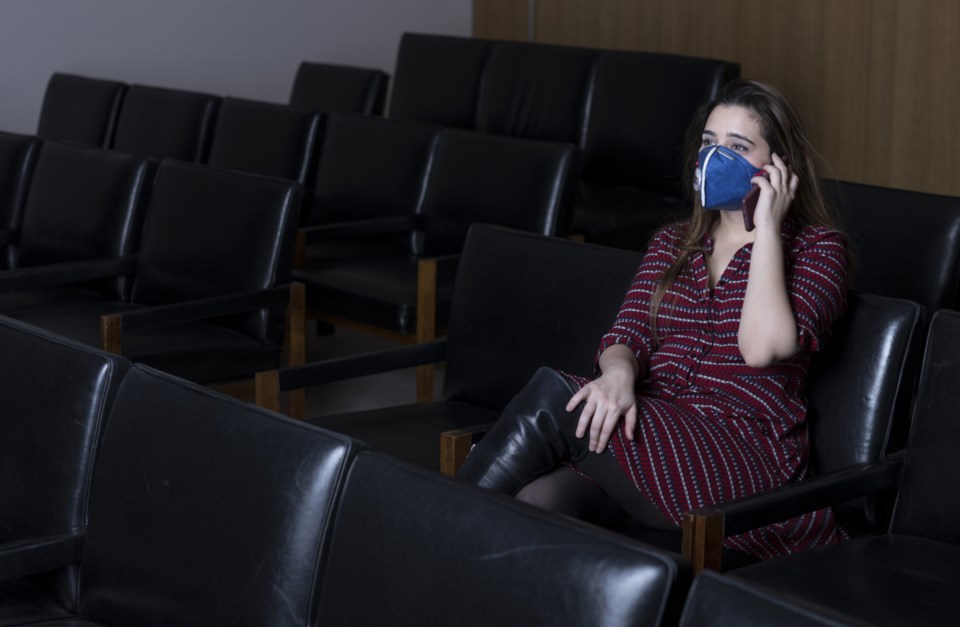Double masking has emerged as a crowd-sourced method for adding extra layers to our masks, using the masks that we have — a response to concerns about the overall direction of the pandemic and the transmissibility of new COVID-19 variants.
When our group recommended cloth masks as a worthwhile additional effort to reduce transmission of COVID-19, some of the masks that we had identified in the literature were three- and four-layer masks: in an experimental setting, they were very effective at blocking particles exhaled by the wearer.
We are a group of epidemiologists and engineers who have been working to summarize what is known about the filtration properties of textiles, to maintain a plain-language website clothmasks.ca, and to create new knowledge about the best textiles to use and the best mask designs.
On the basis of our research review, we recommended two- to four-layer masks, and provided a pattern for making a four-layer mask. Four layers is a challenge, though, in terms of design, particularly for the home or artisanal sewer, and few commercial masks have four layers. To sew a four-layer mask, stitching may have to go through eight layers of material after turning seams, multiplied by three for darts or pleats.
The simple action of wearing two multi-layer masks together gets around this problem. It seems to have arisen, like many good ideas, in a number of places at the same time.
Filtration efficiency
We summarize the protective function of a mask or mask material in terms of the percentage of small particles that it filters out — the filtration efficiency. Every extra layer worn increases the overall filtration efficiency of the mask, though not in a simple way. This was first shown in a laboratory setting in 1919 and confirmed in studies conducted in aerosol labs in Chicago and from the U.S. National Institute of Standards and Technology during the current pandemic.
Nurses working in the 1919 influenza pandemic double masked, wearing two three-layer gauze masks. During the first SARS outbreak in 2003, health-care workers in China made twelve- to sixteen-layer masks when they ran out of certified personal protective equipment. Studies that included people wearing these masks suggested that they did provide protection for the wearer.
Increasing the filtration efficiency is our goal whether we are trying to achieve source control (my mask protects you, your mask protects me) or protection of the wearer (my mask protects me). Health Canada recommends a middle layer of non-woven polypropylene in masks to improve filtration efficiency.
We think that this non-woven material, which can be sewn and washed like a textile, is likely to be a useful addition. Probably the best way to improve the filtration efficiency of masks is to add a layer of polypropylene, either when the mask is made or as a washable filter insert into a pocket masks.
Wearing two such masks together, or one mask with polypropylene with another that you are less sure about, is likely to be a good way to further improve filtration. You can even layer two masks without polypropylene and place a rectangle of polypropylene between masks. The tension of the outer mask will keep it in place.
The non-standardized community masks that we have bought, made or been given, imperfect and varied though they are, are proving effective at reducing transmission in the pandemic. Studies of mask mandates in the United States, Canada and Germany, and between-country comparisons, all consistently show associated reductions in transmission when masks are worn.
Improving filtration further is also likely to be a worthwhile goal: modelling studies show that improving filtration reduces transmission of COVID-19. Adding layers by double masking is a way of using the masks that we already have, possibly to better effect. And we need all the leverage we can find at this point.
Breathability
There is an important caveat. Every layer added also affects breathability, or how it feels to wear the mask in term of the effort of breathing. This is important for comfort and helps keep the mask safe for the wearer.
If you feel short of breath in a double mask, it may be too many layers for you. If you are exercising in a double mask, be alert for the feeling of breathlessness and monitor how it feels; don’t push yourself further than you normally would.
The other problem with the extra layers is that when breathability decreases, it means that the resistance of the mask to the passage of air has increased. This increases the pressure inside the mask and may cause leaking around the edge. Sometimes the double mask, with two sets of head fastenings, will get around this problem because the fit to the face is more snug and held in place by more points.
But there will be diminishing returns if the breathability is so poor that there is significant airflow around the edges of the mask. The aim is to minimize this completely unfiltered air. You can watch out for this when you add the second mask — does the amount of leakage feel less, or more, than when you wore one of the masks alone? And can you breathe comfortably enough for the task you are planning?
At McMaster’s Centre of Excellence in Protective Equipment and Materials, our group is working with commercial mask manufacturers, textile experts, quilters and other home sewers to create alternative designs for masks and test them in the laboratory. Until such studies are done, double masking is a creative innovation that is worth trying out with the masks that you have.![]()
Catherine Clase, Physician, epidemiologist, associate professor, McMaster University; Charles-Francois de Lannoy, Assistant Professor, Chemical Engineering, McMaster University; Juan Jesus Carrero, Professor of Epidemiology, Karolinska Institutet; Roberto Pecoits-Filho, Professor of Medicine, Pontificia Universidade Católica do Paraná, and Scott Laengert, PhD Student, Chemical Engineering, McMaster University
This article is republished from The Conversation under a Creative Commons license. Read the original article.
